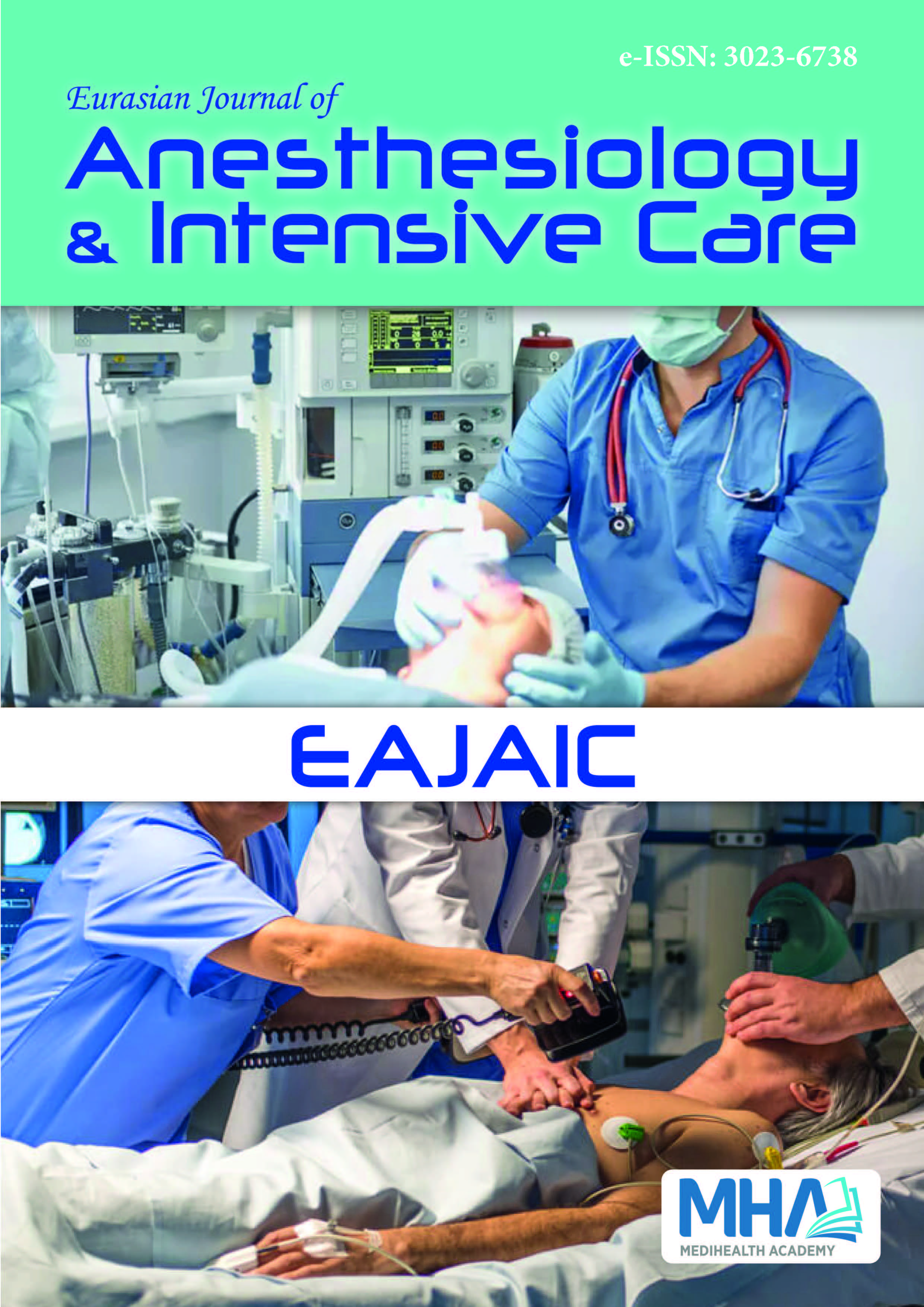1. Kayaaltı S. Anestezi polikliniğine başvuran hastaların anestezive anestezi uzmanı hakkındaki bilgi ve kaygı düzeylerinindeğerlendirilmesi: ilçe devlet hastanesi örneği.JARSS. 2021:29(1):40-51.
2. Uyar Türkyılmaz HE, Camgöz Eryılmaz N, Aydın Güzey N. Hastalarınanestezi hakkında bilgi düzeylerinin saptanması ve anestezi öncesikorkularının belirlenmesi.Çağdaş Tıp Derg. 2018;8(4):350-355.
3. Gottschalk A, Seelen S, Tivey S, Gottschalk A, Rich G. What dopatients know about anesthesiologists? Results of a comparative surveyin an US, Australian, and German university hospital. J Clin Anesth.2013;25(2):85-91.
4. Ribeiro CS, de Barros Mourao JI. Anesthesiologist: the patient’sperception. Braz J Anesthesiol. 2015;65(6):497-503.
5. Garcia-Marcinkiewicz AG, Long TR, Danielson DR, Rose SH. Healthliteracy and anesthesia: patients’ knowledge of anesthesiologist rolesand information desired in the preoperative visit.J Clin Anesth.2014;26(5):375-382.
6. Sheridan SL, Halpern DJ, Viera AJ, Berkman ND, Donahue KE, CrottyK. Interventions for individuals with low health literacy: a systematicreview. J Health Commun. 2011;16(Suppl 3):30-54.
7. Taggart J, Williams A, Dennis S, et al. A systematic review ofinterventions in primary care to improve health literacy for chronicdisease behavioral risk factors. BMC Fam Pract. 2012;13:49.
8. Haugen AS, Eide GE, Olsen MV, Haukeland B, Remme AR, WahlAK. Anxiety in the operating theatre: a study of frequency andenvironmental impact in patients having local, plexus or regionalanaesthesia. J Clin Nurs. 2009;18(16):2301-10.
9. Mavridou P, Dimitriou V, Manataki A, Arnaoutoglou E, PapadopoulosG. Patient’s anxiety and fear of anesthesia: effect of gender, age,education, and previous experience of anesthesia. A survey of 400patients.J Anesth. 2013;27(1):104-108.
10. Kuvvet Yoldaş T, Yoldaş M, Karagöz S, et al. Preanestezikdeğerlendirmede hastaların anestezi uygulamalarına ilişkinbilgi, deneyim ve kaygıları ile ilgili anket çalışması.Ege Tıp Derg.2016;55(3):109-116.
11. Jebb AT, Ng V, Tay L. A review of key Likert scale developmentadvances: 1995-2019. Front Psychol. 2021;12:637547.
12. Sagün A, Birbiçer H, Yapici G. Patients’, who applied to the anesthesiaclinic, perceptions and knowledge about anesthesia in Türkiye. Saudi JAnaesth. 2013;7(2):170-174.
13. de Oliveira KF, Clivatti J, Munechika M, dos Reis Falcão LF. What dopatients know about the work of anesthesiologists? Rev Bras Anestesiol.2011;61(6):720-727.
14. Uma BR, Hanji AS. “Anaesthesia and anaesthesiologists: How famousare we among the general population?” - A survey. J Clin Diagn Res.2013;7(12):2898-2900.
15. Lee JJ, Lee NH, Park CM, et al. Public awareness about the specialtyof anesthesiology and the role of anesthesiologists: a national survey.Korean J Anesthesiol. 2014;66(1):12-17.
16. Baaj J, Takrouri MSM, Hussein BM, Al Ayyaf H. Saudi patients’knowledge and attitude toward anesthesia and anesthesiologists--Aprospective cross-sectional interview questionnaire. Middle East JAnaesthesiol. 2006;18(4):679-691.
17. Hariharan S, Merritt-Charles L, Chen D. Patient perception of the roleof anesthesiologists: a perspective from the Caribbean. J Clin Anesth.2006;18(7):504-509.
18. Aras D, Çil C, Akçaoğlu AC, Erbay RH, Zencir M. Denizli ili YenşehirSağlık Ocağı bölgesinde halkın anesteziyoloji uygulamalarına ilşkinbilgi, tutum ve onceki anestezi deneyimleri. Pam Med J. 2009;2(2):76-82.
19. Ölmez D, Yıldırım H. Hastaların anestezi, anestezist ve görevlerihakkındaki bilgi düzeyleri: anket calışması. Med J İzmir Hosp.2003;9(4):135-139.
20. Demir A, Turan S, Balaban F, Karadeniz Ü, Erdemli Ö. Anesteziuygulamaları ile ilgili olarak preanestezik değerlendirme sırasındahastalarda yapılan anket calışması. J Turk Anaesth Int Care.2009;37(4):225-233.
21. Mavridou P, Dimitriou V, Papadopoulou M, Manataki A, ArnaoutoglouE, Papadopoulos G. Effect of previous anesthesia experience onpatients’ knowledge and desire for information about anesthesiaand the anesthesiologist: a 500 patients’ survey from Greece. ActaAnaesthesiol Belg. 2012;63(2):63-68.
22. Calman LM, Mihalache A, Evron S, Ezri T. Current understanding ofthe patient’s attitude toward the anesthetist’s role and practice in Israel:effect of the patient’s experience. J Clin Anesth. 2003;15(6):451-454.
23. Ng SKS, Chau AWL, Leung WK. The effect of pre-operative informationin relieving anxiety in oral surgery patients. Commun Dent OralEpidemiol. 2004;32(3):227-235.
24. Spalding NJ. Reducing anxiety by pre-operative education: make thefuture familiar. Occup Ther Int. 2003;10(4):278-293.
25. Tolksdorf W, Berlin J, Rey ER, et al. Preoperative stress. Study ofthe mental behavior and parameters of physiological stress in non-premedicated patients during the preoperative period. Anaesthesist.1984;33(5):212-217.
26. Williams JG, Jones JR. Psychophysiological responses to anesthesia andoperation. JAMA. 1968;203(6):415-417.
27. Maranets I, Kain ZN. Preoperative anxiety and intraoperativeanesthetic requirements. Anesth Analg. 1999;89(6):1346-1351.
28. Kil HK, Kim WO, Chung WY, Kim GH, Seo H, Hong JY. Preoperativeanxiety and pain sensitivity are independent predictors of propofoland sevoflurane requirements in general anaesthesia. Br J Anaesth.2012;108(1):119-125.
29. Van Den Bosch JE, Moons KG, Bonsel GJ, Kalkman CJ. Doesmeasurement of preoperative anxiety have added value for predictingpostoperative nausea and vomiting? Anesth Analg. 2005;100(5):1525-1532.
30. Kalkman JC, Visser K, Moen J, Bonsel JG, Grobbee ED, MoonsMKG. Preoperative predictors of severe postoperative pain. Pain.2003;105(3):415-423.
31. Bailey L. Strategies for decreasing patient anxiety in the perioperativesetting. AORN J. 2010;92(4):445-457.

